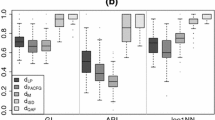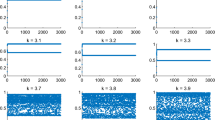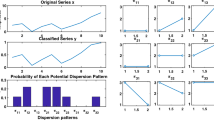Abstract
In this paper, a PDF-induced distance (PID) based on permutation cross-distribution entropy is proposed to measure the dissimilarity between complex time series. It overcomes the effects of spatial distance by focusing on similar local fluctuation patterns. It also corrects the disadvantage of being insensitive to symmetric skewness distributions. We have applied PID to synthetic data and financial time series. The Euclidean distance is employed as a reference. In simulated experiments, eight signals generated from four models are detected, and results are presented by hierarchical clustering analysis via PID, which is correctly clustered and superior to other methods. Then, PID is applied to the real-world financial time series. Eight stocks in the global financial markets are employed. It reveals that they are clearly divided based on their financial backgrounds. The cophenetic correlation coefficient is used to measure the quality of solutions. It reveals that the PID is convincing and superior to the Euclidean distance. In addition, as a classic method for non-stationary time series, detrended cross-correlation analysis (DCCA) is adopted to compare the superiority of PID. Although experiments show that DCCA does perform well, it is inferior to PID. Also, we conduct additional experiments on the effects of non-Gaussian noises. Excitingly, PID can still cluster signals accurately after adding uniformly distributed noises, and the cophenetic correlation coefficient reaches 0.9788.




















Similar content being viewed by others
Notes
Actually, there is a relationship between the effective number of bins ’nbin’ and the corresponding m that: \(\hbox {nbin}(2m+1)-\hbox {nbin}(2m-1)=2m, \hbox {nbin}(2m+2)-\hbox {nbin}(2m)=2m+1, m=1,2,\ldots \). Here, \(\hbox {nbin}(1)=1,~\hbox {nbin}(2)=2\).
References
Wiggins, S.: Introduction to applied nonlinear dynamical systems and chaos. Comput. Phys. 4(4), 843 (1990)
Julier, S.J., Uhlmann, J.K., Durrant-Whyte, H.F.: A new approach for filtering nonlinear systems. In: Proceedings of 1995 American Control Conference - ACC’95. IEEE, Seattle, WA, USA, 21–23 June 1995 (1995). https://doi.org/10.1109/ACC.1995.529783
Wang, H.O., Tanaka, K., Griffin, M.F.: An approach to fuzzy control of nonlinear systems: stability and design issues. IEEE Trans. Fuzzy Syst. 4(1), 14–23 (2002)
Sun, K., Mou, S., Qiu, J., Wang, T., Gao, H.: Adaptive fuzzy control for non-triangular structural stochastic switched nonlinear systems with full state constraints (early access). IEEE Trans. Fuzzy Syst. (2018). https://doi.org/10.1109/TFUZZ.2018.2883374
Qiu, J., Sun, K., Wang, T., Gao, H.: Observer-based fuzzy adaptive event-triggered control for pure-feedback nonlinear systems with prescribed performance (early access). IEEE Trans. Fuzzy Syst. (2019). https://doi.org/10.1109/TFUZZ.2019.2895560
Pun, T.: A new method for gray-level picture threshold using the entropy of the histogram. Signal Process. 2(3), 223–237 (1985)
Schlegel, R., Pfouts, R.W., Hochwald, W., Johnson, G.L.: The entropy law and the economic process. J. Econ. Issues 7(3), 475–499 (1973). https://doi.org/10.1080/00213624.1973.11503122
Studholme, C., Hill, D.L.G., Hawkes, D.J.: An overlap invariant entropy measure of 3D medical image alignment. Pattern Recognit. 32(1), 71–86 (1999)
Coifman, R.R., Wickerhauser, M.V.: Entropy-based algorithms for best basis selection. IEEE Trans. Inf. Theory 38(2), 713–718 (2002)
Lake, D., Richman, J., Griffin, M., Moorman, J.: Sample entropy analysis of neonatal heart rate variability. Am. J. Physiol. Regul. Integr. Comp. Physiol. 283(3), R789 (2002)
Sakoe, H., Chiba, S.: Dynamic programming algorithm optimization for spoken word recognition. IEEE Trans. Acoust. Speech Signal Process. 26(1), 43–49 (2003)
Phillips, S.J., Anderson, R.P., Schapire, R.E.: Maximum entropy modeling of species geographic distributions. Ecol. Model. 190(3), 231–259 (2006)
Machado, J., Duarte, F., Duarte, G.: Analysis of stock market indices with multidimensional scaling and wavelets. Math. Probl. Eng. 2012(2012), 857–868 (2012)
Yin, Y., Shang, P.: Multivariate multiscale sample entropy of traffic time series. Nonlinear Dyn. 86(1), 1–10 (2016)
Shannon, C.E.: A mathematical theory of communication: the bell system technical journal. J. Frankl. Inst. 196(4), 519–520 (1938)
Chen, W., Zhuang, J., Yu, W., Wang, Z.: Measuring complexity using fuzzyen, apen, and sampen. Med. Eng. Phys. 31(1), 61–68 (2009)
Pincus, S.: Approximate entropy (ApEn) as a complexity measure. Chaos 5(1), 110–117 (1995)
Richman, J., Moorman, J.: Physiological time-series analysis using approximate entropy and sample entropy. Am. J. Physiol. Heart Circ. Physiol. 278(6), H2039–H2049 (2000)
Costa, M., Goldberger, A.L., Peng, C.K.: Multiscale entropy analysis of complex physiologic time series. Phys. Rev. Lett. 89(6), 068102 (2007)
Porta, A., Castiglioni, P., Bari, V., Bassani, T., Marchi, A., Cividjian, A., Quintin, L., Di, R.M.: K-nearest-neighbor conditional entropy approach for the assessment of the short-term complexity of cardiovascular control. Physiol. Meas. 34(1), 17 (2016)
Zhao, X., Shang, P.: Measuring the uncertainty of coupling. EPL 110(6), 60007 (2015)
Wang, J., Shang, P., Zhao, X., Xia, J.: Multiscale entropy analysis of traffic time series. Int. J. Mod. Phys. C 24(02), 1883–1896 (2013)
Huang, J., Shang, P., Zhao, X.: Multifractal diffusion entropy analysis on stock volatility in financial markets. Physica A Stat. Mech. Appl. 391(22), 5739–5745 (2012)
He, J., Shang, P.: Comparison of transfer entropy methods for financial time series. Physica A Stat. Mech. Appl. 482, 772–785 (2017)
Yin, Y., Shang, P.: Weighted multiscale permutation entropy of financial time series. Nonlinear Dyn. 78(4), 2921–2939 (2014)
Li, P., Liu, C., Li, K., Zheng, D., Liu, C., Hou, Y.: Assessing the complexity of short-term heartbeat interval series by distribution entropy. Med. Biol. Eng. Comput. 53(1), 77–87 (2015)
Dai, Y., He, J., Wu, Y., Chen, S., Shang, P.: Generalized entropy plane based on permutation entropy and distribution entropy analysis for complex time series. Physica A Stat. Mech. Appl. 520, 217–231 (2019)
Bandt, C., Pompe, B.: Permutation entropy: a natural complexity measure for time series. Phys. Rev. Lett. 88(17), 174102 (2002)
Ausstaniek, M.: Klauslehnertz: parameter selection for permutation entropy measurements. Int. J. Bifurc. Chaos 17(10), 3729–3733 (2007)
Zunino, L., Zanin, M., Tabak, B.M., Pérez, D.G., Rosso, O.A.: Complexity-entropy causality plane: a useful approach to quantify the stock market inefficiency. Physica A Stat. Mech. Appl. 389(9), 1891–1901 (2012)
Takens, F.: Detecting strange attractors in turbulence. In: Lecture Notes in Mathematics, vol. 898, pp. 366–381. Springer, Berlin (1981)
Hénon, M.: A two-dimensional mapping with a strange attractor. Commun. Math. Phys. 50(1), 69–77 (1976)
Granger, C.W.J., Joyeux, R.: An introduction to long-memory time series models and fractional differencing. J. Time Ser. Anal. 1(1), 15–29 (1980)
Hosking, J.R.M.: Fractional differencing. Biometrika 68(1), 165–176 (1981)
Podobnik, B., Horvatić, D., Lam Ng, A., Stanley, H.E., Ivanov, P.C.: Modeling long-range cross-correlations in two-component arfima and fiarch processes. Physica A Stat. Mech. Appl. 387(15), 3954–3959 (2012)
He, J., Shang, P.: q-SampEnAve: an adaptive measurement to recognize the patterns for short-term financial time series. Nonlinear Dyn. 94(3), 1987–2001 (2018)
Boris, P., Eugene Stanley, H.: Detrended cross-correlation analysis: a new method for analyzing two nonstationary time series. Phys. Rev. Lett. 100(8), 084102 (2008)
Zhao, X., Shang, P., Shi, W.: Multifractal cross-correlation spectra analysis on chinese stock markets. Physica A Stat. Mech. Appl. 402(2), 84–92 (2014)
Tsay, R.S.: Analysis of Financial Time Series. Wiley, Hoboken (2002)
Rohlf, F.J., Fisher, D.R.: Tests for hierarchical structure in random data sets. Syst. Zool. 17(4), 407 (1968)
Farris, J.S.: On the cophenetic correlation coefficient. Syst. Zool. 18(3), 279 (1969)
Saraçli, S.: Comparison of hierarchical cluster analysis methods by cophenetic correlation. J. Inequal. Appl. 2013(1), 1–8 (2013)
Filipovic, V., Nedic, N., Stojanovic, V.: Robust identification of pneumatic servo actuators in the real situations. Forschung Im Ingenieurwesen 75(4), 183–196 (2011)
Stojanovic, V., Nedic, N.: Joint state and parameter robust estimation of stochastic nonlinear systems. Int. J. Robust Nonlinear Control 26(14), 3058–3074 (2016)
Acknowledgements
The financial supports from the funds of the Fundamental Research Funds for the Central Universities (2019YJS193).
Author information
Authors and Affiliations
Corresponding author
Ethics declarations
Conflict of interest
The authors declare that there is no conflict of interest regarding the publication of this paper.
Additional information
Publisher's Note
Springer Nature remains neutral with regard to jurisdictional claims in published maps and institutional affiliations.
Rights and permissions
About this article
Cite this article
He, J., Shang, P. & Zhang, Y. PID: a PDF-induced distance based on permutation cross-distribution entropy. Nonlinear Dyn 97, 1329–1342 (2019). https://doi.org/10.1007/s11071-019-05051-0
Received:
Accepted:
Published:
Issue Date:
DOI: https://doi.org/10.1007/s11071-019-05051-0




